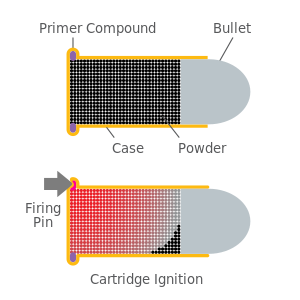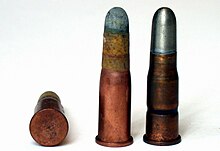Rimfire ammunition

A rim-fire (or rimfire) is a type of
Characteristics


Rimfire ammunition is so named because the
Rimfire cartridges are limited to low chamber pressures because the case must be thin enough so that the firing pin can crush the rim and ignite the primer. Rimfire cartridges of up to .58 caliber were once common when
History

Frenchman
Flobert also made what he called "
6mm Flobert Parlor pistols came into fashion in the mid-19th century; they typically featured heavy barrels. This cartridge was improved upon by Benjamin Houllier in 1846.The next rimfire cartridge was the .22 Short, developed for


American firearms manufacturer J. Stevens Arms & Tool Company introduced the .22 Long Rifle cartridge in 1887.[12] It combined the casing of the .22 Long with the 40-grain (2.6 g) bullet of the .22 Extra Long, giving it a longer overall length, a higher muzzle velocity, and superior performance as a hunting and target round, rendering the .22 Short, .22 Long, and .22 Extra Long cartridges obsolete. The .22 LR uses a heeled bullet, which means that the bullet is the same diameter as the case, which has a narrower "heel" portion that fits into the case. It is one of the few cartridges that are manufactured and used in a large variety of rifles and handguns.

Larger rimfire calibers were used during the
The early 21st century has seen a revival in .17 caliber (4.5 mm) rimfire cartridges.
Shot shells

Some .22 caliber rimfire cartridges are loaded with a small amount of No. 11 or No. 12 shot (about .067 oz (1.9 g)). This "snake shot" is only marginally effective in close ranges, and is usually used for shooting snakes, rats or other small animals. It is also useful for shooting birds inside storage buildings as it will not penetrate walls or ceilings. At a distance of about 10 ft (3.0 m), which is about the maximum effective range, the pattern is about 8 in (200 mm) in diameter from a standard rifle. Special smoothbore shotguns, such as the Marlin Model 25MG "Garden Gun" can produce effective patterns out to 15 to 20 yd (14 to 18 m) using .22 WMR shotshells, which hold .125 oz (3.5 g) of No. 11 or No. 12 shot contained in a plastic capsule.
Shotshells will not feed reliably in some magazine-fed firearms, because of the unusual shape of some cartridges that are crimped closed at the case mouth, and the relatively fragile plastic tips of other designs. Shotshells will not produce sufficient power to cycle semiautomatic actions, because, unlike projectile ammunition, nothing forms to the lands and grooves of the barrel to create the pressure necessary to cycle the firearm's action.
The 9mm Flobert is a notable rimfire cartridge that is still in production in Europe and is chambered by the Winchester Model 36 in the 1920s. This cartridge is primarily loaded with a small amount of shot, but can also fire a small ball, and is used in "
List of current production rimfire ammunition
- .17 Hornady Magnum Rimfire(.17 HMR): a .17 caliber cartridge based on a modified .22 WMR case.
- .17 Hornady Mach 2 (.17 HM2): a .17 caliber cartridge based on a modified .22 Stinger case.[14]
- .17 Winchester Super Magnum (.17 WSM): a .17 caliber cartridge based on a modified .27 caliber nail gun blank cartridge.
- 5mm Remington Rimfire Magnum (5mm RFM): a .20 caliber rimfire cartridge that is based on the .22 Winchester Magnum Rimfire case, it has greater muzzle energy, longer range, and a flatter trajectory over many of the other rimfire cartridges.
- .22 BB Cap: also known as 6mm Flobert in Europe, uncommon but still available.
- .22 CB Cap: a slightly longer version of the .22 BB Cap rimfire cartridge, uncommon but still available.
- 25 m Rapid Fire Pistolcompetition shooting, until being replaced by .22 Long Rifle in 2005, uncommon but still available.
- .22 Long: a longer and slightly more power rimfire cartridge that is based on the .22 Short, uncommon but still available.
- self-defence.
- .22 Winchester Rimfire (.22 WRF): also known as the .22 Remington Special, it has slightly more muzzle energy than the more common .22 Long Rifle rimfire cartridge, uncommon but still available.
- .22 Winchester Magnum Rimfire (.22 WMR): also known as the .22 Magnum, this is a longer rimfire cartridge based on the .22 Winchester Rimfire cartridge with an increase in both muzzle energy and velocity.
- 9mm Flobert: is a garden guncartridge that is still used in Europe, uncommon but still available.
- .22 Winchester Automatic: also known as the .22 Win Auto, it was only chambered for the Winchester Model 1903 semi-automatic rifle, uncommon but still available.
See also
- Heeled bullet
- Cartridge (firearms)
- Centerfire ammunition
- List of rimfire cartridges
- Primer (firearm)
References
- ^ "History of firearms" Archived 22 December 2015 at the Wayback Machine (fireadvantages.com)
- ^ "How guns work" Archived 22 December 2015 at the Wayback Machine (fireadvantages.com)
- ISBN 978-1-61608-287-1. Retrieved 23 July 2020.
- ^ Bussard, Michael (2010 )"The Impossible .22 Rimfire", American Rifleman
- ^ "History of firearms" Archived 22 December 2015 at the Wayback Machine (fireadvantages.com)
- ^ "How guns work" Archived 22 December 2015 at the Wayback Machine (fireadvantages.com)
- ^ Shooting section (la section de tir) Archived 10 November 2013 at the Wayback Machine of the official website (in French) of a modern indoor shooting association in Belgium, Les Arquebusier de Visé.
- ISBN 978-0-89672-439-6. Retrieved 25 January 2012.
- ISBN 978-0-89689-455-6.
- ISBN 978-0-89689-936-0. Retrieved 25 January 2012.
- ^ "Small Arms Ammunition at the International Exposition Philadelphia, 1876" (PDF). 1972. Archived from the original (PDF) on 25 December 2019. Retrieved 2 December 2019.
- ISBN 978-1-58160-122-0
- ^ ISBN 0-87349-605-1.
- ^ "Hornady's New .17 Mach 2 by Chuck Hawks".
Further reading
- Suydam, Charles R. The American Cartridge: An Illustrated Study of the Rimfire Cartridge in the United States. Alhambra, Calif: Borden Pub, 1986. OCLC 26915839
